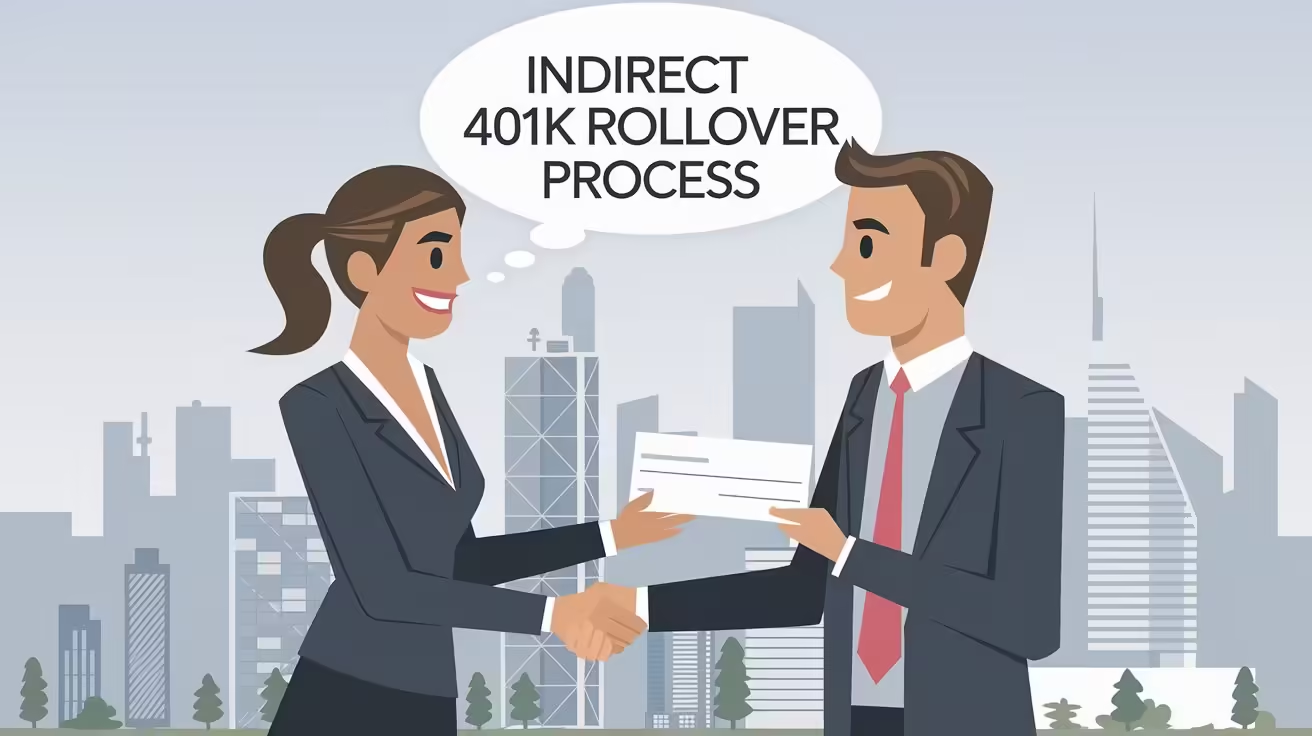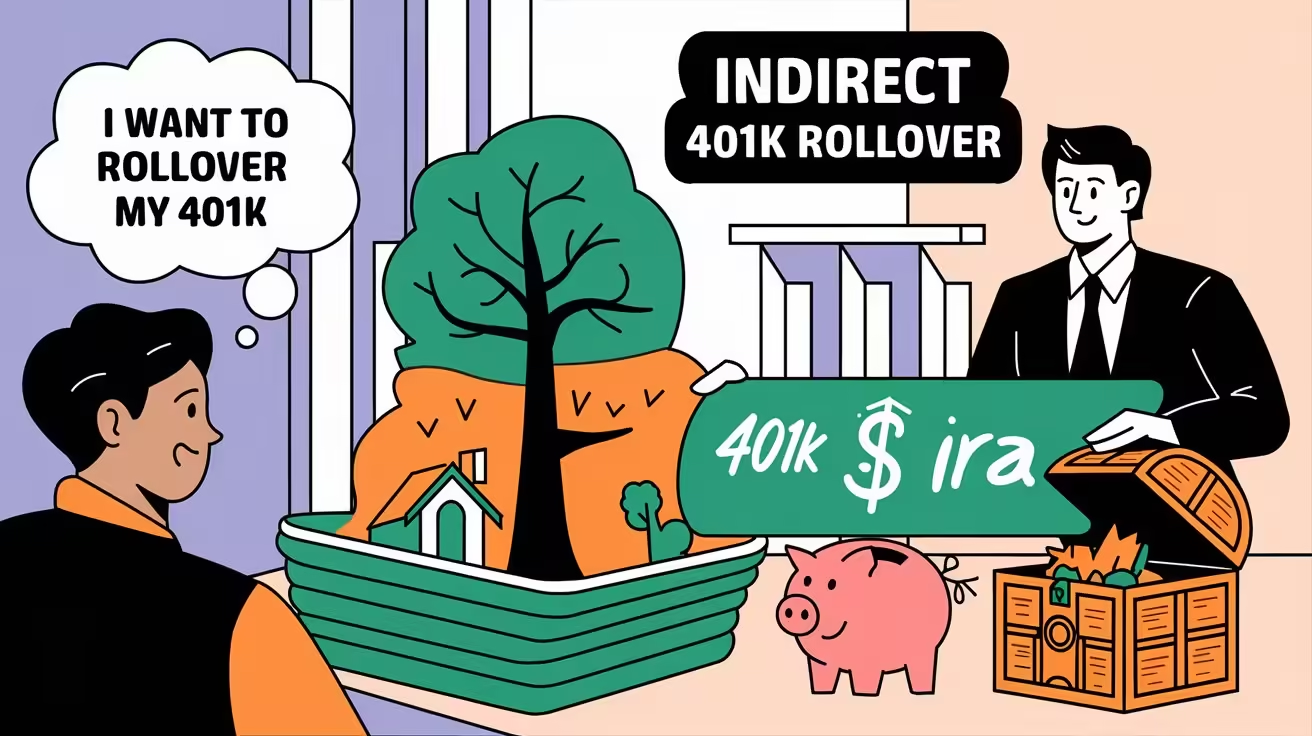Unlocking the Potential of an Indirect 401k Rollover

An indirect 401k rollover can be an attractive option when you’re shifting gears in your career or nearing retirement. This process allows you to transfer funds from one retirement account to another, giving you flexibility in managing your investments. But with flexibility comes responsibility, and without careful handling, the IRS can step in with significant penalties. Transfer Pension to IRA: Unlock 5 Powerful Benefits.
In this comprehensive guide, we’ll explore everything you need to know about an indirect 401k rollover—its benefits, the risks, and how to navigate the process successfully.
Introduction: Understanding the Indirect 401k Rollover
An indirect 401k rollover involves transferring your retirement funds from a 401k plan into another qualified retirement account, such as an IRA, through a short-term cash distribution. Unlike a direct rollover, where the money moves directly between financial institutions, an indirect 401k rollover places the responsibility on you to complete the transaction within 60 days.
This method offers temporary access to your retirement funds. But here’s the catch: failure to adhere to IRS rules could result in costly taxes and penalties. Understanding the nuances of this process is critical to protecting your retirement savings.
What Is an Indirect 401k Rollover?
An indirect 401k rollover occurs when you withdraw funds from your 401k account and have 60 days to deposit them into another retirement account, like an IRA or a new 401k. During that 60-day window, you have access to the funds and can use them however you like, but this flexibility comes with strings attached. The IRS requires you to deposit the funds back into a qualified account, or else they’ll treat the withdrawal as a distribution, which could lead to taxes and penalties.
Indirect 401k Rollover vs. Direct 401k Rollover
You may be asking: how does an indirect 401k rollover differ from a direct rollover? The key difference lies in the flow of funds.
- Direct 401k Rollover: Here, the money is transferred directly from your old 401k account to a new qualified retirement account without you ever touching the funds. This method is simpler and avoids the risks of taxes and penalties.
- Indirect 401k Rollover: With an indirect rollover, the funds are disbursed to you. You then have 60 days to redeposit them into a qualified retirement account.
If you miss the 60-day deadline, the IRS will treat the amount as a taxable distribution, potentially subject to income tax and a 10% early withdrawal penalty if you’re under the age of 59½.
Why Choose an Indirect 401k Rollover?
There are several reasons why you might choose an indirect 401k rollover. One of the main advantages is the temporary access to your retirement funds without having to permanently withdraw them. You could use these funds to meet short-term financial needs, such as paying off high-interest debt or covering a large purchase.
Another scenario where an indirect 401k rollover could make sense is if you’re between jobs or waiting to set up a new retirement account. It offers flexibility, but only if you follow the rules.
The 60-Day Rule: A Crucial Timeline
The 60-day window is the linchpin of an indirect 401k rollover. If you fail to redeposit the full amount within that time frame, the IRS will view the withdrawal as an early distribution.
This can trigger significant tax consequences, especially if you’re under 59½. Here’s what could happen:
- Income Tax: The distribution will be added to your taxable income for the year.
- Early Withdrawal Penalty: If you’re below retirement age, the IRS imposes a 10% penalty on the amount.
To avoid these penalties, it’s essential to be meticulous with timing. Mark the deadline on your calendar the day the funds are withdrawn, and aim to complete the rollover well before the 60-day mark.
IRS Withholding and Tax Implications
One of the most misunderstood aspects of an indirect 401k rollover is the mandatory 20% withholding. When you withdraw funds from your 401k, the plan administrator is required by law to withhold 20% for taxes. Even if you plan to deposit the full amount into another retirement account within 60 days, this withholding applies.
Here’s an example: if you roll over $50,000, your plan will withhold $10,000 for taxes. To avoid a partial taxable distribution, you’ll need to redeposit the full $50,000 by finding an additional $10,000 from your own pocket to cover the gap. The withheld amount will be credited when you file your taxes, but failing to make up for the 20% can result in taxation on the missing portion.

Advantages of an Indirect 401k Rollover
Though riskier than a direct rollover, the indirect 401k rollover has its advantages. Here are a few reasons it might work in your favor:
- Temporary Access to Funds: You can access your retirement savings for short-term needs without permanently withdrawing them.
- Flexibility in Investment Choices: You gain the freedom to choose how and where to reinvest the funds, giving you control over your retirement strategy.
- Potential Tax Deferral: If handled correctly, you can defer taxes by reinvesting the full amount within 60 days.
Despite these benefits, it’s crucial to tread carefully to avoid pitfalls.
Risks and Drawbacks of an Indirect 401k Rollover
While an indirect 401k rollover offers flexibility, the risks can easily outweigh the benefits if mishandled:
- Tax Consequences: Missing the 60-day deadline could mean paying income tax on the distribution and a 10% early withdrawal penalty if you’re under 59½.
- 20% Withholding: The IRS requires your employer to withhold 20% of your distribution for taxes, which can complicate the rollover process.
- Loss of Compounded Growth: If you use the funds during the 60-day window, you’re missing out on potential investment gains.
These risks underscore the importance of fully understanding the rules before embarking on an indirect 401k rollover.
How to Complete an Indirect 401k Rollover Successfully
To successfully navigate an indirect 401k rollover, follow these steps carefully:
- Withdraw the Funds: Request a distribution from your 401k plan. Remember, 20% will be withheld for taxes.
- Mark Your Calendar: As soon as you receive the distribution, start counting down the 60 days to avoid missing the deadline.
- Deposit the Full Amount: To avoid penalties, deposit the entire distribution into another qualified retirement account, including the 20% that was withheld. You’ll need to cover this gap out of pocket initially.
- File Taxes: When you file your taxes, you’ll be credited for the 20% that was withheld.
By following these steps, you can avoid taxes and penalties while still enjoying short-term access to your retirement funds.
Common Mistakes to Avoid in an Indirect 401k Rollover
Even seasoned investors can make errors when handling an indirect 401k rollover. Here are some common mistakes to avoid:
- Missing the 60-Day Deadline: The IRS is strict about the 60-day window. Missing the deadline results in a taxable distribution and potential penalties.
- Forgetting About the 20% Withholding: If you don’t deposit the withheld amount from your own funds, you’ll face taxes on the shortfall.
- Rolling Over to a Non-Qualified Account: Make sure you’re rolling over the funds into an eligible retirement account, such as a traditional IRA or another 401k.
- Not Consulting a Financial Advisor: It’s always wise to consult with a tax professional or financial advisor when handling retirement funds to ensure you’re making the best decisions.
For more information regarding Finance Basic you can visit FinancewithAi Channel & Home
The Tax Implications of an Indirect 401k Rollover
Taxes play a pivotal role in shaping the pros and cons of an indirect 401k rollover. Understanding the tax implications of this process can be the difference between a seamless transfer and an expensive mistake. While we’ve touched on taxes earlier, let’s dive deeper into how they work and what you can do to minimize your exposure.
When you opt for an indirect 401k rollover, one of the first things that happens is the automatic withholding of 20% of your distribution for federal taxes. This rule is non-negotiable—it applies to every indirect 401k rollover, regardless of your financial standing or intentions for the funds. The withheld amount serves as a form of “down payment” on what the IRS may perceive as a future taxable distribution, ensuring that taxes are accounted for upfront in case the funds are not rolled over within the 60-day period.
Here’s where it can get tricky: even though the IRS withholds 20%, you still need to redeposit the full amount of your distribution within the 60-day window. This means you’ll need to come up with extra cash from other sources to replace the 20% that’s been withheld. For instance, if your distribution was $50,000, the IRS will withhold $10,000, and you’ll receive $40,000. To avoid taxes and penalties, you’ll need to deposit the full $50,000 into your new retirement account within the 60-day timeframe. Failure to do so will result in the portion you didn’t redeposit being treated as taxable income for the year.
Another important point is that the 20% withholding only covers federal taxes. Depending on where you live, you may also owe state taxes on any amount not rolled over in time. Some states also have early withdrawal penalties that mimic the IRS’s 10% penalty, so it’s important to understand your local tax laws before proceeding with an indirect 401k rollover.
One bright spot: if you successfully complete the rollover and cover the missing 20%, you’ll be credited for the amount that was withheld when you file your taxes. In other words, that $10,000 the IRS took upfront will either reduce your overall tax bill for the year or be refunded to you, depending on your specific tax situation.
The Importance of Professional Guidance in Indirect 401k Rollovers
One of the best ways to ensure that you don’t get tripped up by the complex rules of an indirect 401k rollover is to seek professional advice. Whether it’s a tax advisor, a financial planner, or even the HR representative at your workplace, getting expert insight can help you avoid the common pitfalls associated with rollovers.
Financial advisors can offer tailored strategies to help you understand whether an indirect 401k rollover is the best option for your financial situation. In many cases, these professionals may even suggest a direct rollover, which eliminates the 60-day rule and withholding challenges altogether. While indirect rollovers offer temporary access to your funds, they often involve more headaches and risks than they’re worth.
Moreover, a tax advisor can guide you on how best to handle the tax consequences of an indirect rollover, especially if you’re unsure how to cover the 20% withholding upfront. They can help you assess your current tax obligations and provide advice on whether it makes sense to withdraw additional funds from other sources, like savings or a loan, to cover the shortfall.
For individuals with substantial 401k balances, mistakes can be especially costly. Taxes on large sums, combined with potential penalties, can quickly turn what should be a tax-advantaged transaction into a financial burden. By enlisting the help of professionals who understand the intricacies of tax law and retirement accounts, you can avoid these costly errors.

Penalties for Missing the 60-Day Deadline
Missing the 60-day deadline is one of the most serious mistakes you can make with an indirect 401k rollover. Once the deadline passes, the IRS considers the distribution as a permanent withdrawal from your retirement account, which means you’ll be subject to both ordinary income tax and a 10% early withdrawal penalty if you’re under the age of 59½.
Let’s say you’ve received a $50,000 distribution and fail to redeposit it into another qualified retirement account within 60 days. In this case, the full $50,000 would be added to your taxable income for the year, potentially bumping you into a higher tax bracket. On top of that, if you’re under 59½, you’ll also be hit with a 10% penalty on the entire $50,000, amounting to an additional $5,000.
Furthermore, once the distribution is treated as taxable income, you lose out on the opportunity for those funds to grow tax-deferred in a retirement account. Over time, this loss of compounded growth could significantly reduce your overall retirement savings.
It’s worth noting that the IRS does provide some exceptions to the 60-day rule. In rare cases of hardship, such as natural disasters or severe illness, you can apply for a waiver to the 60-day deadline. However, these waivers are not guaranteed, and the burden of proof is on you to demonstrate why you were unable to meet the deadline. Given the steep penalties involved, it’s generally better to avoid getting close to the 60-day mark in the first place.
How to Avoid Pitfalls in an Indirect 401k Rollover
Navigating an indirect 401k rollover successfully requires careful attention to detail. By following a few simple steps, you can reduce your risk of running into tax problems or penalties:
- Start the rollover process immediately: As soon as you receive the funds from your old 401k, set up your new retirement account and deposit the funds. Don’t wait until the 60-day deadline is looming.
- Keep track of withholding: Remember that 20% of your distribution will be withheld for taxes. Make sure you have enough funds from other sources to cover this shortfall when you deposit the funds into your new account.
- Work with a professional: Whether it’s a financial advisor or tax professional, don’t go it alone. These experts can help you navigate the process and avoid costly mistakes.
- Stay organized: Keep detailed records of when you received the distribution and when you redeposited the funds. If you’re ever audited by the IRS, having accurate documentation will make the process smoother.
- Consider a direct rollover: If you’re not in immediate need of the funds, a direct rollover is almost always the safer, simpler option. By having the funds transferred directly from one account to another, you eliminate the risk of missing the 60-day deadline and avoid the 20% withholding altogether.
Strategic Uses for Indirect 401k Rollovers
While the risks of an indirect 401k rollover are significant, there are scenarios in which this strategy could make sense. For example, if you’re temporarily between jobs or need quick access to cash for a short-term financial obligation, an indirect rollover can offer a solution. As long as you’re confident you can redeposit the full amount within 60 days, this approach gives you short-term liquidity while keeping your long-term retirement savings intact.
Some individuals also use indirect 401k rollovers as a way to consolidate multiple retirement accounts. If you’ve changed jobs multiple times throughout your career and have several 401k accounts scattered across different employers, rolling them into a single IRA or 401k account can simplify your retirement planning. By carefully executing an indirect rollover, you can consolidate your accounts and gain better control over your investment strategy.
In these cases, the key to success is timing and organization. With a clear plan in place and professional guidance, an indirect rollover can provide the flexibility you need without exposing you to unnecessary taxes or penalties.

Thoughts on Indirect 401k Rollovers
An indirect 401k rollover is not for everyone. While it offers temporary access to retirement funds and the ability to consolidate accounts, the risks associated with the 60-day rule and 20% withholding often outweigh the benefits. However, for those who need quick access to cash and are confident they can meet the IRS’s requirements, an indirect rollover can be a useful tool in managing their financial future.
Ultimately, the decision to pursue an indirect 401k rollover should be made carefully, with a full understanding of the tax implications and potential penalties involved. Consulting with a financial advisor or tax professional can help you determine whether this strategy aligns with your long-term retirement goals. Whether you choose an indirect or direct rollover, the most important thing is to stay informed, follow the rules, and protect your hard-earned retirement savings.
FAQs On Indirect 401k Rollover
What happens if I miss the 60-day deadline?
If you miss the deadline, the IRS will treat the distribution as taxable income, and if you’re under 59½, you’ll also incur a 10% early withdrawal penalty.
Do I have to redeposit the full amount, including the 20% withholding?
Yes. To avoid penalties, you need to redeposit the entire amount, including the 20% that was withheld for taxes. You’ll be credited for the withholding when you file your taxes.
Can I use the funds during the 60-day window?
Yes, but be cautious. If you don’t repay the full amount, you’ll face taxes and possibly penalties on the distribution.
What if I don’t have enough to cover the 20% withheld?
You’ll face taxes on the portion that wasn’t redeposited, and if you’re under 59½, you may also face the 10% early withdrawal penalty.
Is there a limit on how often I can do an indirect rollover?
Yes. You can only complete one rollover per year for IRAs, though the rule doesn’t apply to 401k accounts.
Should I choose an indirect rollover over a direct one?
It depends on your financial situation. An indirect rollover offers temporary access to funds, but a direct rollover is simpler and less risky.
Conclusion: Is an Indirect 401k Rollover Right for You?
An indirect 401k rollover can provide flexibility, but it also comes with risks that need careful management. If you need temporary access to your retirement funds or are between retirement accounts, this method may suit your needs. However, due to the 60-day rule and the 20% withholding, it’s often simpler and safer to opt for a direct rollover.
Ultimately, the decision to pursue an indirect rollover should be made with the guidance of a financial advisor who understands your long-term goals. By following the rules, you can leverage an indirect 401k rollover to enhance your financial flexibility without sacrificing your retirement savings.